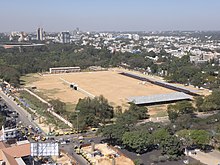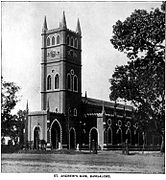Bangalore Cantonment
The Bangalore Cantonment (1806–1881) was a military
History and Layout

Prior to the arrival of the British, Bangalore had been the stronghold of several
Capture of Bangalore Fort
Bangalore was the strongest
Tipu Sultan followed Cornwallis' army, placing him in the awkward position of having an undefeated enemy army at his back while besieging the strong fortification. Tipu kept away hoping to take assault when underway in flank. Over the next twelve days, two companies of the Madras Pioneers provided sappers for eight batteries, dug several parallels and a trench up to the fort ditch. Cornwallis attacked secretly on the night of 21 March 1791. The Madras Pioneers, led by Lt Colin Mackenzie, crossed the ditch with scaling ladders, mounted the breach and entered the fort, while the artillery engaged the fort with blank ammunition. With a breach made, the main stormers rushed in and the fort was captured after a hand-to hand fight in which a thousand defenders were killed. Cornwallis captured the fort and secured the force against Tipu.[2]
The Madras Pioneers, went on to make Bangalore their permanent home.
Establishment of cantonment
The British found Bangalore to be a pleasant and appropriate place to station their garrison and therefore moved their garrison to Bangalore from Srirangapatna. The origin of the word cantonment comes from the French word canton, meaning corner or district. Each cantonment was essentially a well-defined and clearly demarcated unit of territory set apart for the quartering and administering of troops.[3] The heart of the Bangalore Cantonment was the Parade Ground. The Civil and Military Station (CMS) grew around the Parade Ground.

The installation of the Bangalore Cantonment attracted a large number of people from

Development
The names of many of the cantonment's streets were derived from military nomenclature such as
-
St Andrews Kirk, Bangalore around 1895 - Furneaux, JH (1895) Glimpses of India. A grand photographic history of the Land of Antiquity, the vast Empire of the East
See also
- Cox Town, Bangalore
- Cooke Town
- Fraser Town, Bangalore
- Murphy Town, Bangalore
- Austin Town
- Kingdom of Mysore
- Sir Mirza Ismail
- Bangalore East Railway Station
- Bangalore Cantonment railway station
- List of areas in Bangalore Cantonment
- List of schools in Bangalore Cantonment
- Plaza Theatre (Bangalore)
References
- ^ "The Cantonment Side of Bangalore". Chronicles of the London Missionary Society. 1890. Retrieved 2 November 2015.
- ^ a b Sandes, Lt Col E.W.C. (1933). The Military Engineer in India, Vol I. Chatham: The Institution of Royal Engineers. pp. 163–165.
- ^ The Story of a City, East West Books (Madras) Pvt. Ltd., Jayapal Maya
- ^ Destination: Bangalore. Bangalore Information
- ^ St. John's Church, Bangalore, India
- ^ http://hdl.handle.net/10919/9941 Archived 5 June 2012 at the Wayback Machine Public space in Bangalore: Present and Future Projections

